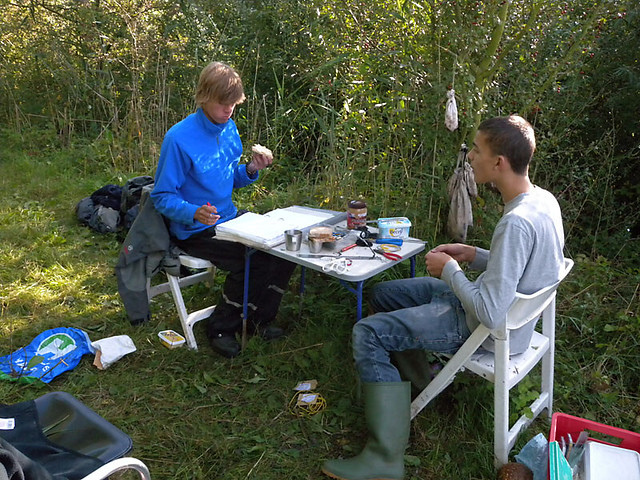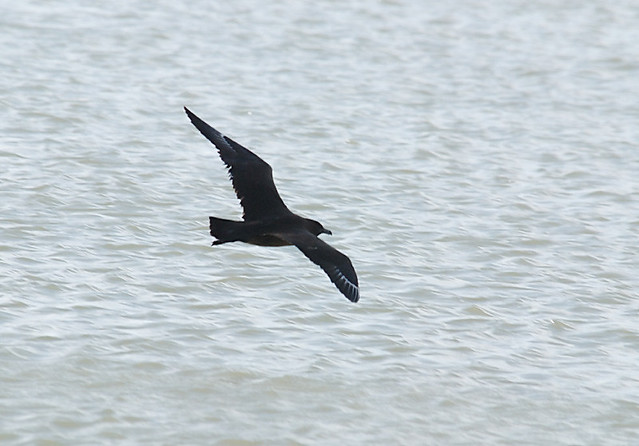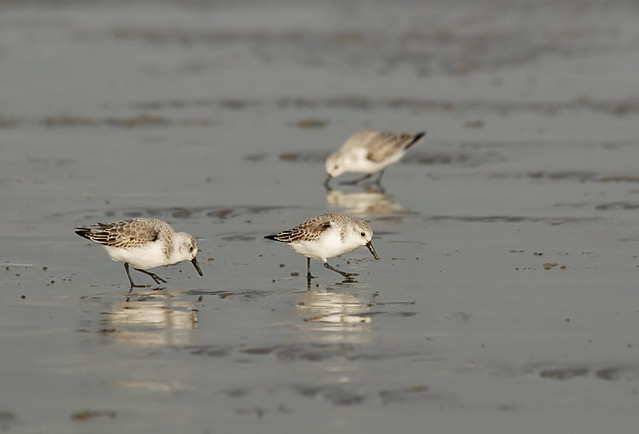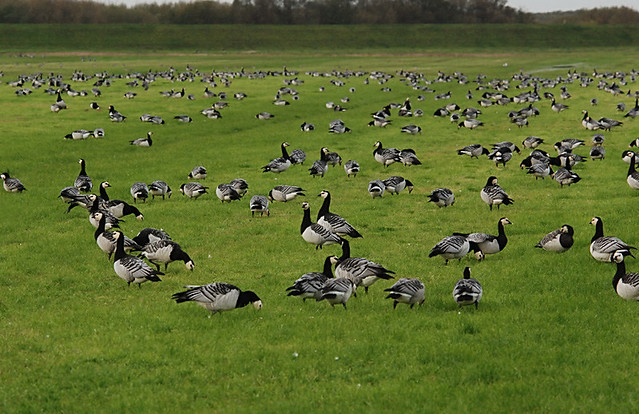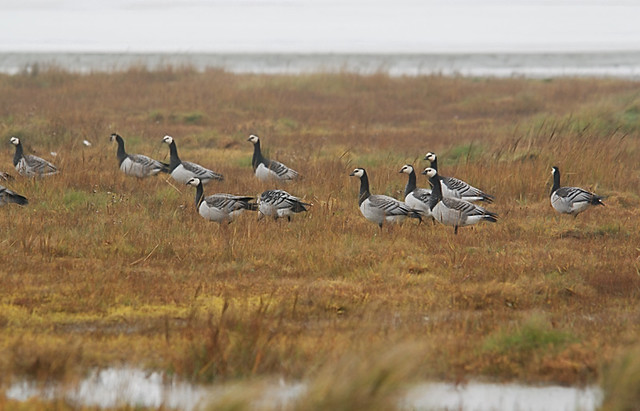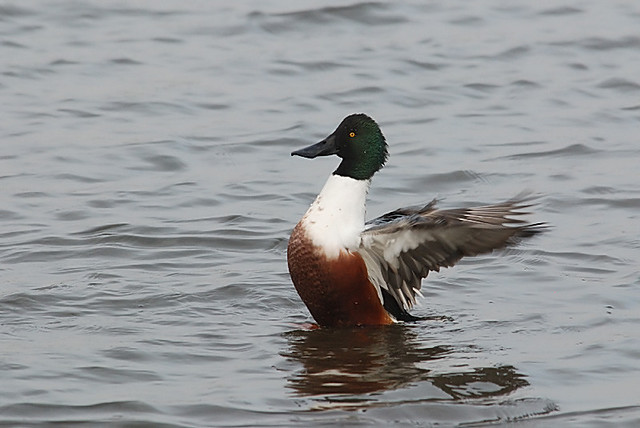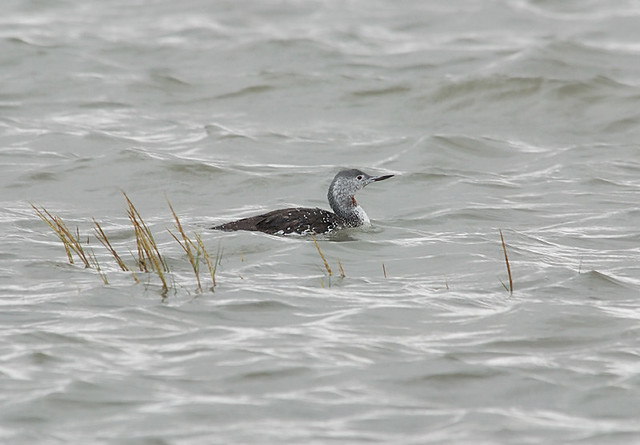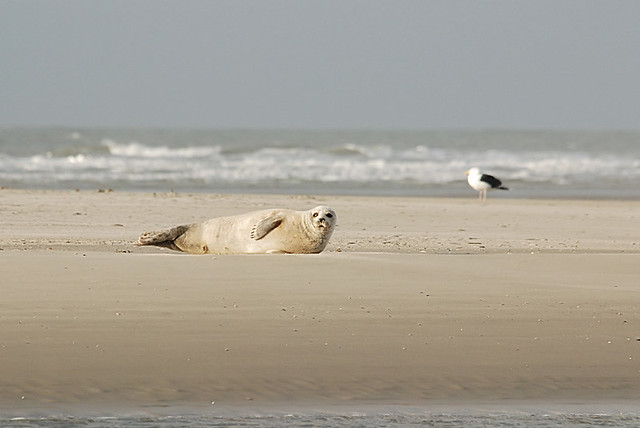Arrival on Monday morning at 10.15. A little bit cloudy with a strong wind (force 5). From a distance I see some people at the Waddendijk. They are probably watching the Desert Wheatear, which was discovered yesterday. Just arrived at the spot it turns out that the bird has flown into the Banckspolder. Fortunately we discover the bird sitting on a blue fence wire at a distance of 150 metres. Through the scope I see a little light brown bird balancing in the wind. We are just arrived und have already seen a rare bird.
We move on to our appartment in the centre of the village. In front of our appartment there are bushes with berries where Waxwings had their breakfast this morning. At the moment Redwings and young male black birds are eating from the berries. These 1st year birds are very beauriful with their dull black plumage being in contrast with the red berries. Even the bill is black.
We cycle along the yacht-harbour and the Waddendijk. In the harbour we hear and see 3 Horned larks flying over. Meanwhile it is high tide. At the "hoogwaterplaats" (small area of mud left uncovered by the sea where birds roost during high tide) beside the harbour are roosting especially Oystercatchers, Red knots and Bar-tailed Godwits.
Some hunderd metres further along the dike I discover a red-throated diver in partial summer plumage. The grey head and the red throat are very clear to see.
The weather has become better: no clouds and the sun is shining.
Then in front of me I see a dark gull approaching me along the dike. The gull has white spots on the upper- and underwings : a Great Skua!
What a great start of our first day at Schier: a Desert Wheatear, Red-throated diver and a Great Skua.
We cycle on. After the ferry harbour we see a Whimbrel fouraging in one of the pools beside the cycle track. Via the "kwelderpad" and the "Johan de Jongpad" we cycle through the dunes to the Wasserman, a German Bunker from World War 2. The dunes are full of Trushes like Blackbirds, Redwings, Song Trushes and Fieldfares. In the innerdunes Robins are producing their typical ticking call.
In the holy park "Klein Zwitserland" we are looking for the Waxwings. At the small postoffice I hear their typical call. A flock of 10 Waxwings are eating berries from a hawthorn very close to the road.. The are not shy and we can watch them in a close distance. But they don't like cars , so the birds fly away when a car is passing the bushes. The birds stay away for a couple of minutes and then return to their meal.
At the end of the afternoon I return to the "Waddendijk" hoping to see the Desert Wheatear in a closer distance than this morning.I'm lucky: she (it is a 1st year female) is sitting on the wire alaong the ditch that runs parallel to the cycle track. She dives to the ground frequently to look for food between the old crop. Some metres further she lands again on the wire.
We can see the details of the bird very well: the almost black tail , fully pale beige colour of the breast, mantle and head. When the sun disappears behind some clouds I see a more greyish plumage, black greater coverts (grote dekveren), dark primaries and seconadries (hand-en armpennen) with pale shaps. No supercilium. This young female is off course. Could it be a Eastern bird? Probably yes. Desert Wheatears are mostly seen in autumn. I saw my first Desert Wheatear 10 April 2005 in the Fochtelooër Veen, my second bird on 16th November 2008 on the beach of Nordsee coast.

Before sunset a quick look at the "wad", where it is low tide. Some curlews, Bar-tailed Godwits, Shelducks and Grey Plovers are fouraging. Sometimes I hear their melancholic call. At the "jachthaven" a flock of Bramblings is fouraging in a hidden way between the seaweed. First I don't recognize the call, it isn't the typical Brambling call, but a short finchlike call. At the end of the harbour I see one spotted redshank on the wad.
It is round 6 pm and I'm getting cold and hungry. I turn back to our appartment to cook a substantial meal. At 18.15 I get a phonecall: a bluetail has just been seen at the Monnik, a holyday park. It's already getting dark, so I decide to check the place tomorrow
Tuesday:
the day starts with sunshine. I cycle to the Monnik. The guys of the JNM have already checked the bushes and trees. No Bluetail is found..
The wind is blowing from NW, there is a no migration. I take some pictures of Sanderlings in beautiful light on the beach of the Marlijn.
A Horned Lark is flying over the beach and lands in front of me. The bird is calling till his mate passes by. Both birds continue their flight. The clouds are coming and the the rest of the day is gloomy. On my way back to the voillage I see a hunting Merlin. Barnacle Geese are feeding on the meadows south of the village. In the afternoon it is raining.
Wednesday:
heavy clouds, no sun. We walk across the Westerstrand. Some Common Snipes and only 1 Jack Snipe are flying up.. Barnacle geese are feeding along the wet and mud places.
On our way back to the village we pass the site of the Waxwings, which are still there. Together with blackbirds they are are eating the berries .
Nearby I hear a treecreeper. Unfortunayely it is'n t the Scandinavian Treecreeper. The bird has a smaller step between the 6th and 7 primary. The
certhia familiaris (the Scandinavian subspecies) has a longer step, lower flanks greyish-white to white, a prominent white supercilia, that is wide behind the eye. This bird has a clear one, but no longer step, which is distinctive.
In my opinion there are less Dark-bellied Brent Geese than in other years. I see mainly large flocks of Barnacle Geese
Thursday: After breakfast I'm sitting an hour or so in the hide at the Westerplas. It is a good site to watch the ducks.: Shovelers, Gadwalls, Common Teals and Pintails. Especially the Shovelers are coming close to the hide:
Then raptor time is starting at the Westerplan. A hunting Goshawk causes a lot of panic under the waterfowl : all the ducks are flying up. After some time a Sparrowhawk is skimming over the stretch of water , which makes less impression on the waterfowl then the Goshawk. There is no sign of panic or alarm. Around 10.00 I start to pack up my things and meanwhile I'm scanning the surroundings with result. At the left side I see a raptor approaching at full speed the hide. The bird is brown with a clear mustache. The immature Peregrine Falcon turns to the right and is crossing the water. Strange enough the waterfowl doesn't react to the hunting Falcon.
It is a beautifull start of the day, but rain is in the air. At 10.30 it starts raining.
In the afternoon the weather is becoming better. I go to the jachthaven again, hoping to see Twites. I haven't seen or heard them this week yet. However, today I'm overlooking these birds again. The Red-throated Diver is still there an swimming not that far. I have my boots so I can approach the bird over the dry wad to make some photos.
Along the Waddendijk 3 Snow Buntings, in the Middle Dunes a lot of flying Siskins and Bramblings; besides the cyle track through the salt marsh 3 little egrets, Reed Buntings, Goldfinches and Meadow Pipits. At the Marlijn (Restaurant) we walk some kilometres along the dunes. In the wet parts of the beach a lot of Common Snipes, no Jack Snipes. Along the track besides the dunes a lot of Goldfinches.
At least we cycle to the Strandhotel at the end of the "Badweg". Here we see a lot of Goldfinches too. We are suprised to see a lot of Seals resting on the sandbars. The group consits of 22 animals.
We can approach them easily , as there is a stretch of water between them and the tourists. They stay relaxed till a wife is coming closer and stepping resolutely into the water. For some seals this is the sign to leave. Fortunately the wife is recognizing the results of her behaviour and walks back. The rest of the seals stays at the sandbar.
One white seal is resting apart from the group.
To end the day we visit, of course, the Jachthaven, to check for some unexpected stuff. There is only a first year Wheatear scratching around. In the Banckspolder a female Hen Harrier glides over the fields.
Friday 29 October: our last day at the isle. We pack our bags and leave it in the appartment. The weather is gloomy with a strong wind. Where is the promised thinny sun? We cycle to the Westerstrand first. A lot of goldfinches are feeding at thistles. Flocks of Barnacle Geese are flying from the Wad to the meadows. We make a last try to see the Twites at the Jachthaven. This time we are lucky. A flock of about 20 birds is feeding in the "drijfzandbak", a small area surrounded by a small dike, wihich contains dried mud and plants with seeds. You can see the small yellow bills very well in the scope. Some birds have the pale pink-coloured glow on their bellies. The birds are very restless: the are feeding for some minutes flying from one plant to another then flying away across the dike, coming back again for feeding and flying away again. The 4 Horned Larks are quite easier to watch. A watery sun is shining now. We visit the hide at the Westerplas for a last view. Pintails, Shovelers, Common Teals, Wigeons are swimming close to the hide. At 13.45 we leave to the ferry and cycle on the track on the innersides of the Waddendijk hoping to see the Desert Wheatear on our way back again. She is still there, on the same spot as Monday. I take some pictures. After a suprising welcome at Schiermonnikoog now a suitable goodby by the same rare bird.

The next day, Saterday 30 October, we hear that the Desert Wheatear has left the isle. It is well-known, that Wheatears continue migrating at the end of the day, as they can orientate on the setting sun. Probably this bird did the same.












